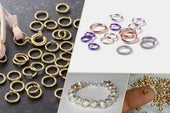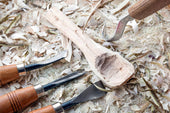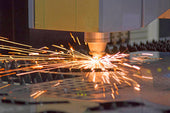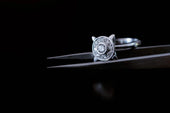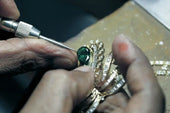Casting is a common manufacturing process that can be used to make jewelry or metal parts. The casting process is used in a variety of industries, including the jewelry industry and the aerospace industry. Although there are many different methods of casting, the basic principles of operation are similar. Molten metal or other types of materials are poured into pre-made molds and then molded into new shapes.
1. Sand mold casting process
Sand mold casting is one of the oldest methods of casting. The most special thing about it is - the model is made of sand. Of course the sand here is not the kind of sand we see in our daily life which is loose and not easy to be molded, but the sand is molded into the shape we want with a special binder.
Sand, a raw material, is very easy to obtain and can be kneaded into a variety of complex shapes in a short period of time. Therefore, this is the reason why this type of casting has been able to exist for such a long time.
But this method also has the same disadvantages that cannot be ignored. After each casting, the mold made of sand cannot be reused. Therefore, the sand casting method is not suitable for mass production. Moreover, it is impossible to make the surface of the mold made of sand smooth. Therefore, most of the finalized parts have to be sanded or polished before the final product is considered finished.
2. lost wax casting

The heart of the lost wax casting method lies in the fact that the model of the part is made of wax. After the wax mold is evaporated, the metal is melted and then slowly poured into the cavity for casting. After a period of time, the molded metal part can be removed. Nowadays, there are casting machines on the market that combine the three functions of vacuuming, melting metal and casting, which can save you a lot of trouble.
The advantage of lost wax casting is the ability to create metal parts that are more complex in appearance. This is due to the fact that wax is a softer material and therefore less difficult to work with. The surface of the metal parts produced by Lost Wax Casting is generally smooth, so the post-processing work is naturally reduced.
However, the lost wax casting method also has certain disadvantages, that is, the input cost for the actual operation of this method is very high. Moreover, this method is difficult for beginners because it involves the making of the sprue. If you do not have a certain amount of experience it is very difficult to get started.
3. Die casting process
Die casting is actually a process of casting under high pressure. Die casting is more suitable for processing materials such as aluminum and zinc. Moreover, the die casting process is particularly suitable for mass production of metal parts.
You could even say that the die casting process brings together the best of most die casting methods. The speed at which the die casting process produces products is actually very fast. And the quality of the products that are produced are still good, with little or no finishing work required.
Although, you can hardly pick out the disadvantages of the die casting process. However, compared to other casting processes, the equipment cost of die casting process is still slightly higher. So, this is why only some large manufacturers will choose to use die casting process to produce their products.
4. Permanent mold casting
Permanent casting means that the same mold is used to cast the product all the way through the production process. Of course, the molds used here are special. The material used to make the mold is physically very stable, durable and heat resistant. Metals such as steel or aluminum are used to make permanent mold casting molds. Permanent mold casting is generally used to produce engine parts for automobiles.
The advantage of permanent mold casting is that it is capable of mass production of products, and it can make those products that require high precision. The most important thing is that the service life of the mold is very long, do not have to change the mold all the time.
Although this permanent mold is very durable, the cost of manufacturing a permanent mold is quite high and the process of producing it takes a long time.

5. Centrifugal casting
Centrifugal casting is mainly used to cast simple cylindrical parts, like pipes or wheels. What makes the operation of centrifugal casting different from other casting processes is the mold. After the metal is melted, it is poured into a rotating mold. Centrifugal casting produces a product that is very dense and has a more uniformly distributed internal structure. Overall, the products produced by centrifugal casting are still more durable.
But centrifugal casting can not produce some of the more complex appearance of the product, and centrifugal casting of the whole process requires the cost of money is relatively high. This is because the centrifugal casting on the equipment requirements are very high, and also need to operate people with certain specialized knowledge.










